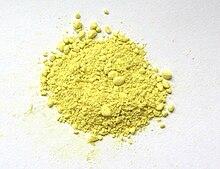Aloin
| Structural formula | |||||||||||||||||||
|---|---|---|---|---|---|---|---|---|---|---|---|---|---|---|---|---|---|---|---|

|
|||||||||||||||||||
| Aloin A | |||||||||||||||||||
| General | |||||||||||||||||||
| Surname | Aloin | ||||||||||||||||||
| other names |
|
||||||||||||||||||
| Molecular formula | C 21 H 22 O 9 | ||||||||||||||||||
| External identifiers / databases | |||||||||||||||||||
|
|||||||||||||||||||
| properties | |||||||||||||||||||
| Molar mass | 418.4 g mol −1 | ||||||||||||||||||
| safety instructions | |||||||||||||||||||
|
|||||||||||||||||||
| As far as possible and customary, SI units are used. Unless otherwise noted, the data given apply to standard conditions . | |||||||||||||||||||
Aloin (also barbaloin ) is a substance from the group of 1,8-dihydrohxy anthracenes , which is isolated from aloe species. The glycosidic substance crystallizes in yellow needles, smells faintly of aloe and has a bitter taste. Aloin occurs in two diastereomeric forms, aloin A (barbaloin A) and aloin B (barbaloin B), which occur in different proportions depending on the species .
history
Aloin was first isolated as a natural substance from Barbados aloe in 1851 . This was recognized by E. Leger in 1897 as an anthraquinone derivative. It was not until 1952 that Mühlemann succeeded in clarifying the exact structure.
The ingredient, previously called isobarbaloin and identified through the Rosenthaler reaction, could be assigned the structure of 7-hydroxyaloin , which occurs in both diastereomeric forms in West Indian aloe , but not in Cape aloe .
Occurrence
Aloin is not only found in over 20 species of aloe, but also in the American buckthorn bark ( Rhamnus purshiana ). The content of aloin in different types of aloe varies between 5 and 40% depending on their type, origin and seasonal conditions (based on the aloe drug, i.e. the dried plant sap).
In-vivo studies on the biosynthesis of aloins have shown that aloin B is synthesized by the plant, while the isomer aloin A is formed secondarily by conversion from aloin B.
Extraction and presentation
In addition to the extraction from dried aloe and subsequent processing by means of recrystallization or column chromatography , the diasteromeric mixture of aloin A and aloin B can be synthesized from aloe-emodin-9-anthrone, α- bromoacetoglucose and sodium hydroxide using a wet chemical method.
meaning
Aloin is the active ingredient of the herbal drug aloe, which can be used in standardized preparation as a laxative for the short-term treatment of occasional constipation . Long-term intake of aloe can lead to disturbances in the water and electrolyte balance, in particular to potassium losses. Protein and blood can appear in the urine ( albuminuria , hematuria ). Overdosing leads to symptoms of intoxication, which manifest themselves in cramp-like pain and severe diarrhea, which can lead to life-threatening electrolyte and water losses. Also kidney infections are described. The therapeutic importance of aloe has declined against the background that there are better tolerated substances.
proof
A sample taken in chloroform shows - applied to a sample medium (TLC plate) - after spraying with a methanolic 10% KOH solution a yellow color which intensifies under UV light (365 nm). This evidence is based on the fact that in the alkaline the anthrone-anthranol equilibrium shifts to the side of the anthranol form. Using UV-VIS spectroscopy , three maxima can be observed at 297, 287 and 354 nm.
Web links
Individual evidence
- ↑ a b Aloin data sheet at Sigma-Aldrich , accessed on March 9, 2011 ( PDF ).
- ^ Ian R. Tizard, Kenneth M. Yates, Yawei Ni: Aloes - The genus Aloe. Ed. Tom Reynolds, CRC Press 2004, ISBN 978-0-415-30672-0 , p. 12.
- ↑ Pharmaceutical Substance List, 12th Edition 2001, Advertising and Sales Association of German Pharmacists.
- ↑ HW Rauwald and R. Voetig, Arch. Pharm. 315, 477 (1982).
- ↑ BM Abegaz, BT Ngadjui, M. Bezabih, LK Mdee: Novel natural products from marketed plants of eastern and southern Africa. Pure Appl. Chem. , Vol. 71 (1999)., No. 6, pp. 919-926.
- ↑ Final community herbal monograph on Aloe barbadensis Miller and on Aloe (various species, mainly Aloe ferox Miller and its hybrids) (PDF; 109 kB) Committee on Herbal Medicines of the European Medicines Agency, October 26, 2006.
- ↑ Aloe in the medicinal plant lexicon of the cooperation Phytopharmaka GbR, accessed June 7, 2012.


